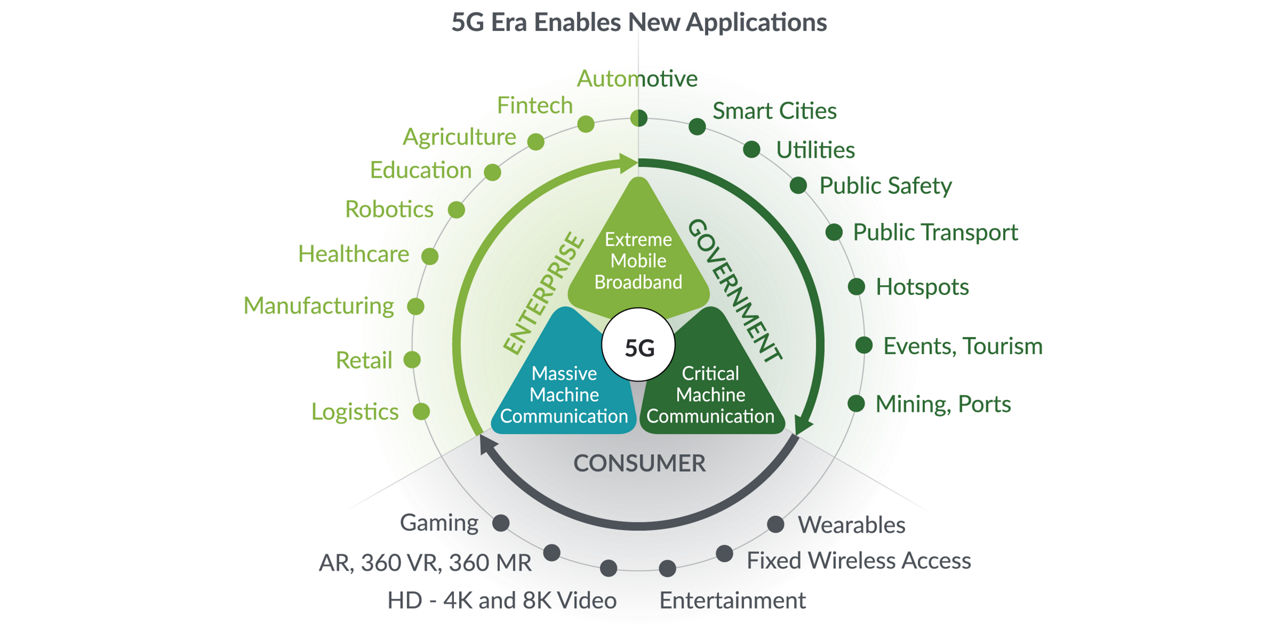What is 5G?
What is 5G?
5G is the fifth generation of wireless network technology. The next global wireless standard after 4G, 5G enables a new kind of network that’s designed to deliver higher data speeds, lower latency, and support more users, devices, and services while simultaneously improving network efficiency.
5G supports three broad categories of use cases.
- Enhanced Mobile Broadband (eMBB) — High bandwidth services for wireless connectivity.
- Ultra-Reliable Low Latency Communication (URLLC) — Ultra reliable and low latency communication for critical requirements.
- Massive Machine Type Communication (mMTC) — Reliable communication for billions of sensors and monitoring devices.
Downlink peak data rates for 5G can reach up to 20 Gbps, which is 20 times faster than the 4G LTE peak speed of 1 Gbps. Similarly, 5G is expected to deliver a 10- to 100-fold increase in user experience data rates, support 10 to 100 times the number of connected devices that 4G supports, and feature super-low latency in the order of 1 millisecond (ms).
The 5G era will go beyond improved network performance and speed, delivering innovative new and enhanced connected experiences for users. 5G can improve business application performance while enabling new user experiences and services in areas such as augmented, virtual reality, and mixed reality applications (AR, VR, and MR), videoconferencing, industrial automation, self-driving cars, and connected medical devices.
What Problems Does 5G Solve?
Service providers will use 5G to handle ever-growing data traffic by significantly lowering the cost per bit. 5G also gives service providers an opportunity to prevent the decline in average revenue per user (ARPU) by enabling new 5G services for consumers, government, and enterprises.

Enterprises are expected to be biggest beneficiaries of 5G technologies, benefitting from improved productivity, agility, and scalability for their services. For example, the biggest change expected will most likely be in industrial automation, where factories will be served by wirelessly controlled robots. In these environments, even the smallest moving parts will be wirelessly tracked, operated, and managed along the production line.
Healthcare is another major focus vertical for 5G use cases. Remote surgery or connected ambulances will help save lives in areas where it’s impossible for doctors to reach. With 5G-driven capabilities, retailers will offer new experiences (for example, AR, VR, and MR) in trying, styling, and buying products, whether in brick and mortar stores or outside of stores.
On the consumer slide, cloud gaming is an emerging application for which heavy gaming clients are not needed, and games are directly rendered from the 5G network edge. AR and VR traffic is now roughly 20% of the traffic in some early 5G deployments. The use of Fixed Wireless Access (FWA) to provide 5G residential broadband services is also gaining traction.
On the government side, smart cities, utilities, and public safety agencies can benefit significantly from 5G capabilities. Connected cars and automotive solutions can contribute to safer roads and saving human lives.
How Does 5G Work?
5G requires new technology components to be able to meet the new capacity and latency requirements:
- New spectrum: To achieve high data rates, 5G must be able to use new spectrum bands above 6 GHz, centimeter (cm) wave band (6 to 30 GHz) and millimeter (mm) wave bands (> 30 GHz). 5G will also be deployed in spectrum bands below 6 GHz. The low bands provide the coverage, and the higher bands provide capacity.
- Massive MIMO: Multiple-Input and Multiple-Output (MIMO) is a method for multiplying the capacity of a radio link, using multiple transmission and receiving antennas. Massive MIMO, in contrast, is a MIMO system with an especially high number of antennas (for example, 8, 16, 64, 128, and so on). Massive MIMO increases spectral efficiency and network coverage.
- 5G New Radio (5G NR): The new 5G radio access technology is 5G NR, developed by 3GPP for the 5G mobile network. 5G NR is based on ultra-lean design principles, reducing signaling and energy consumption. 5G NR is also designed with a flexible frame structure to efficiently multiplex diverse 5G services, as well as provide forward compatibility for future 5G services.
- Open RAN: Open RAN stands for open radio access network. Specifically, Open RAN is an ongoing shift in mobile network architectures that enables service providers the use of non-proprietary subcomponents from a variety of vendors. Specific proprietary components like Baseband Units (BBU) and Remote Radio Head (RRH) are now disaggregated to centralized units (CU), distributed units (DU), and radio units (RU). With Open RAN, the new disaggregated functions can also be virtualized or containerized. The O-RAN Alliance takes it a step further by ensuring that the interfaces between these components are open and interoperable.
- 5G Core Network (5 GC): As standardized by 3GPP, the 5GC is architected as a service-based architecture (SBA). All core network functions are implemented based on cloud-native principles, including separation of user plane and control planes, stateless network functions, open interfaces, and APIs. Core network functions can be easily deployed, updated, and scaled to launch new services at a lower cost.
- 5G transport: Serving new 5G use cases such as eMBB, URLLC, mMTC needs a transport network that can handle not only a huge increase in traffic, but also the wide variety of network characteristics for each specific use case. It must meet the needs of a growing range of devices, services, and new business models. To enable massive capacity, transport networks should be capable of supporting 25G, N x 25G in the access/pre-aggregation layer, 100G, N x 100G in the aggregation layer, and up to 400G in the service provider core. In addition, the transport network needs to comply with stringent timing requirements to support latency of less than 10 ms.
- Network slicing: With the use of network slicing, multiple independent end-to-end logical networks can be run on a shared physical infrastructure. Each slice can provide a specific quality of services (QoS) for a service or application. A network slice can span across multiple parts of the network (access network, core network, and transport network).
- Edge computing: Computing, storage, and networking resources can move closer to subscribers and end-users with edge computing. The closer proximity improves response times and saves bandwidth. Edge computing, also known as edge cloud, can be deployed within customers premises, such as enterprises and factory floors, managed or hosted by a service provider.
- Telco cloud: An open platform, telco cloud helps service providers avoid vendor lock-in, and it allows them to capitalize on a broad ecosystem of cloud-native functions that will enhance infrastructure, improve operations, and enable greater service velocity. Telco cloud enables service agility and rapid service innovation, giving service providers the ability to unleash a new wave of applications and services that will reinvigorate their business models.
- Security: New attack surfaces arise with 5G, IoT, network slicing, and edge computing. Threats can come from anywhere, and they’re increasing in volume, frequency, and sophistication. If the existing security approach is not enhanced, 5G security can be a bottleneck to performance. Siloed systems and manual response are no longer effective. What’s needed is a connected approach that takes a comprehensive view of the network and the external ecosystem to become fully threat aware, dynamically adapting and enforcing security policies consistently throughout the network.
- Management and orchestration (MANO): 5G can significantly increase the number of connected end-user devices, nodes, and services within the network. It’s impossible to manage network operations manually at the required scale and quality. The only practical way to address the scale and complexity of future cloud and 5G networks is to automate operations, with full support for Open APIs to work in multivendor, multicloud environments, building continuous knowledge through AI and ML capabilities.
Pioneering 5G Network Technology
5G is part of the broader revolution that also embraces cloud and automation technologies to drive a more robust and sustainable platform for service providers. Juniper Networks believes 5G alone is not enough to drive service provider business transformation. In order to truly capture value and realize the possibilities that these technologies promise, service providers must consider cloud, 5G , and automation collectively. These technologies build on each other and, in some cases, even depend on each other to work.
For example, many of the benefits of 5G cannot be optimized without cloudification of the infrastructure, whether it’s telco cloud and NFVI, distributed edge cloud, or functions that are virtualized, containerized (VNF/CNFs), or disaggregated. While 5G and cloud together deliver quantum leaps in scale, performance, and agility, they also create more operational complexity that can only be simplified and managed with network automation.
5G and cloud promise new experiences for consumers and enterprises. To thrive in today's 5G/multicloud services landscape, service providers need a strategy that simplifies network operation and delivers differentiated customer experiences. At Juniper, we refer to this as Experience-First Networking.
Our approach to Experience-First Networking for service providers focuses on three key solution areas:
• Scalable IP services fabric for efficient IP Transport
• Cloud-first approach to simplifying Telco and Edge Cloud
• Managed enterprise services for assured service experiences
Each of these solution areas is underpinned by our experience enablers:
• Connected Security safeguards users, devices, applications, and infrastructure
• Intelligent Automation simplifies complexity for a better customer experience
5G FAQs
What is the difference between 4G and 5G?
5G is designed to provide downlink peak data rates up to 20 Gbps, which is 20 times faster than the 4G LTE peak speed of 1 Gbps. Also, 5G is expected to deliver a 10- to 100-fold increase in user-experienced data rates, support 10 to 100 times the number of connected devices that 4G supports and feature super-low latency in the order of 1 millisecond (ms). 5G enables new innovative user experiences and services in areas such as augmented reality (AR), virtual reality (VR), and mixed reality (MR) applications, industrial automation, self-driving cars, and connected medical devices.
Why do service providers need 5G?
Service providers will require 5G to handle the ever-growing data traffic by significantly lowering the cost per bit. 5G also offers service providers an opportunity to prevent the decline in average revenue per user (ARPU) by enabling new 5G services for consumers, government, and enterprises.
What complementary technologies are necessary to make 5G possible?
The following technologies assist in meeting the new capacity and latency requirements of 5G:
5G transport: 5G use cases require a transport network that can handle not only a huge increase in traffic, but also the wide variety of network characteristics for each specific use case.
Automated operations: 5G significantly increases the number of connected end-user devices, nodes, and services within the network. The only practical way to manage the scale and complexity of future cloud and 5G networks is to automate operations, by building continuous knowledge through artificial intelligence (AI) and machine learning (ML) capabilities.
Network slicing: Through network slicing, multiple independent end-to-end logical networks can be run on a shared physical infrastructure with each slice capable of providing quality of service (QoS) for an individual service or application.
Telco cloud: An open telco cloud platform helps service providers avoid vendor lock-in and enables them to capitalize on a broad ecosystem of cloud-native functions to deliver new 5G applications and services.
Security: New attack surfaces arise with 5G, IoT, network slicing, and edge computing. A connected security approach is fully threat aware, taking a comprehensive view of the network and its external ecosystem, and dynamically adapting and enforcing security policies consistently throughout the network.
What 5G technology, solutions, and products does Juniper offer?
Juniper provides the key building blocks to help service providers transform their business with 5G through a combination of our own robust portfolio and strategic partner offerings:
- Scalable IP services fabric with network slicing for efficient IP Transport
- Cloud-first solutions for simplifying Telco and Edge Cloud
- Managed enterprise services for assured service experiences
- Intelligent Automation simplifies complexity for a better customer experience
- Connected Security safeguards users, devices, applications, and infrastructure























